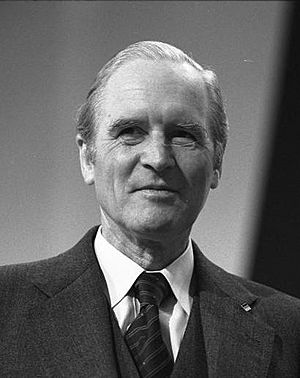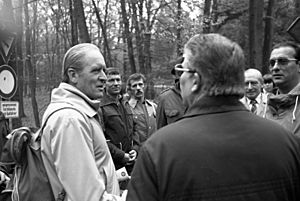Karl Carstens facts for kids
Quick facts for kids
Karl Carstens
|
|
|---|---|
 |
|
| President of Germany West Germany |
|
| In office 1 July 1979 – 30 June 1984 |
|
| Chancellor | Helmut Schmidt Helmut Kohl |
| Preceded by | Walter Scheel |
| Succeeded by | Richard von Weizsäcker |
| President of the Bundestag West Germany |
|
| In office 14 December 1976 – 31 May 1979 |
|
| Preceded by | Annemarie Renger |
| Succeeded by | Richard Stücklen |
| Bundestag Leader of the CDU/CSU Group | |
| In office 17 May 1973 – 1 December 1976 |
|
| Preceded by | Kurt Georg Kiesinger (Acting) |
| Succeeded by | Helmut Kohl |
| Chief of the Federal Chancellery West Germany |
|
| In office 1 January 1968 – 22 October 1969 |
|
| Chancellor | Kurt Georg Kiesinger |
| Preceded by | Werner Knieper |
| Succeeded by | Horst Ehmke |
| Member of the Bundestag for Ostholstein |
|
| In office 3 October 1976 – 1 July 1979 |
|
| Preceded by | Constituency established |
| Succeeded by | Günther Jansen |
| Member of the Bundestag for Schleswig-Holstein |
|
| In office 19 November 1972 – 3 October 1976 |
|
| Personal details | |
| Born | 14 December 1914 Bremen, German Empire |
| Died | 30 May 1992 (aged 77) Meckenheim, Germany |
| Political party | Christian Democratic Union (1955–1992) |
| Other political affiliations |
Nazi Party (1940–1945) |
| Spouse | Veronica Prior |
| Education | Yale University, University of Burgundy, Goethe University, Ludwig Maximilian University of Munich, University of Königsberg, University of Hamburg |
| Signature | |
Karl Carstens (born December 14, 1914 – died May 30, 1992) was an important German politician. He served as the president of West Germany from 1979 to 1984. The president is the head of state in Germany.
Contents
Early Life and Education
Karl Carstens was born in the city of Bremen, Germany. His father was a teacher who sadly died in World War I before Karl was born.
From 1933 to 1936, Karl studied law and political science. He attended several universities, including those in Frankfurt, Dijon, Munich, Königsberg, and Hamburg. He earned a doctorate degree in 1938. Later, in 1949, he also earned a Master of Laws (LL.M.) degree from Yale Law School in the United States.
Military Service During World War II
During World War II, from 1939 to 1945, Carstens was a soldier. He was part of an anti-aircraft artillery unit in the German air force, known as the Luftwaffe. By the end of the war, he had reached the rank of Leutnant, which is like a Second Lieutenant.
In 1940, he joined the Nazi Party. He had also joined a related group called the SA in 1934. People joined these groups for various reasons during that difficult time in German history.
Post-War Career and Politics
In 1944, Karl Carstens married Veronica Prior, who was a medical student. After the war, he became a lawyer in his hometown of Bremen. From 1949, he worked as a councillor for the city's government. He also taught at the University of Cologne starting in 1950.
In 1954, Carstens joined the German diplomatic service. He worked for the German Foreign Office and represented West Germany at the Council of Europe in Strasbourg. In 1955, he joined the Christian Democratic Union (CDU) political party.
From 1966 to 1969, during a special "grand coalition" government, he held important roles. He first worked in the Ministry of Defence. After 1968, he became the head of the German Chancellery, which is like the chief of staff for the German Chancellor.
Member of Parliament and President of the Bundestag
In 1972, Carstens was elected to the Bundestag, which is the German parliament. He was a member of parliament until 1979. From 1973 to 1976, he led the CDU/CSU group in the Bundestag.
During this time, he was a strong critic of certain left-wing movements. He sometimes accused the ruling Social Democratic Party of Germany (SPD) of not being tough enough on left-wing extremists. He also criticized the famous author Heinrich Böll for his novel The Lost Honour of Katharina Blum, linking it to left-wing terrorism.
After the 1976 elections, the CDU/CSU became the largest group in parliament. On December 14, 1976, Carstens was elected President of the Bundestag. This role is similar to the speaker of a parliament.
President of West Germany
On May 23, 1979, Karl Carstens was elected as the fifth President of the Federal Republic of Germany (West Germany). He won against the SPD candidate, Annemarie Renger.
During his time as president, Carstens became well-known for hiking across Germany. He did this to connect with ordinary people and show that politicians were not so different from them.
In December 1982, the new Chancellor Helmut Kohl (CDU) deliberately lost a vote of confidence in the Bundestag. This was done to allow for new elections and hopefully gain a stronger majority. This action led to a debate about whether it was fair to the Constitution. However, on January 7, 1983, President Carstens dissolved the Bundestag and called for new elections. The Federal Constitutional Court approved his decision, and new elections took place on March 6, 1983.
In 1984, Carstens decided not to seek a second term as president because of his age. He left office on June 30, 1984, and was succeeded by Richard von Weizsäcker.
Karl Carstens was a member of the Evangelical Church in Germany.
See also
 In Spanish: Karl Carstens para niños
In Spanish: Karl Carstens para niños



